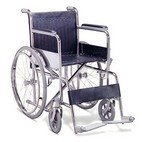The short video above best illustrates what I have to contend with each night when my paralytic spasms begin. The jerking leg movements you see in the video are spontaneous and I have little control over them. They 'trigger' every six seconds to every twelve to fifteen seconds and usually last one or two hours although the longest episode I experienced was eight hours.
My leg is jumping on its own - I am not assisting the movement!
Paralytic Spasms -they are almost as devastating as the paralysis itself. (but then there is also the nerugenic burning pain, sciatic pain and the stiffness too!) How do you wish to be tortured? Which agony will come to the forefront today?
I am on the maximum oral dose of Baclofen, however, I find it does acts more on tightness does little to reduce the spontaneous repeated contraction of muscles. 'Drip, drip, drip of neurotransmitter? Does the injury prevent some signal which would allow the neurotransmitter to dissipate and therefor not accumulate until the 'neurotransmitter bucket' is full and now overflowing? Drip, spasm, drip, spasm, drip, spasm...
Devastating as they are, I don't wish to have some doctor insert a tube into my spine connected to a liquid Baclofen pump to shoot this drug directly into my spinal column. My opinion on the doctors I've encountered can be found elsewhere in this blog.
While I can get spasms any time of the day, they usually do not last long in the daytime. It is only at night when they come on in full force with the leg becoming increasingly "creepy feeling" and then the contractions begin.
I don't believe it is because at night I'm reclined in bed with my feet up. I may lay down during the day to read a book or such with no spasms at all. Night time seems to be the common denominator in this puzzling formula. Does one's physiology change so much at night and if so, what physiological product produce (or is lacking) triggers these unbearable contractions? What is the exact mechanism by which Baclofen is supposed to work? (another blog post?)
So you can see how devastating they can be. I can show you the jerking motion but I can't give you a real sense of the 'creepy inflated burning tingling' sensation that ramps up when the spasms are about to start and last until they peter out.
Just as a moderate example: If my leg jumps, say, once every 10 seconds, over three hours it would have jumped 1080 times. Just try to sleep with some demon grabbing your leg and yanking on it all night long! The above video shows the motion while I'm on my back. On my stomach, the motion lifts my heel to the ceiling.
On rare occasions, putting pressure on the foot by placing it on a flat surface and pressing down on it may help. Most times it just has to run its course -and hope you remain somewhat sane at the end!
I had previously wondered why my pain and spasms were so bad when my injury (infection around the T5 - T7 location) did not seem so severe. While I still cannot walk unsupported, I have proprioception, sensation and can slightly wiggle some toes on either foot. Then it occurred to me. Perhaps my pain and spasms are so bad because my injury was not so severe. If someone has a partial severing (crushing, intrusion, etc) of the spinal column, those fibers no longer connect and cannot transmit. Perhaps my spinal column is intact but due to the bacterial toxins and enzymes, the pathway is modified but the signals can get through. I only know my own level of pain and sensation and no one else so how can anyone realistically judge another person's severity of sensation? Perhaps what I feel as severe, someone else thinks is moderate or vice versa. Curious...
* * *







.jpg)

No comments:
Post a Comment